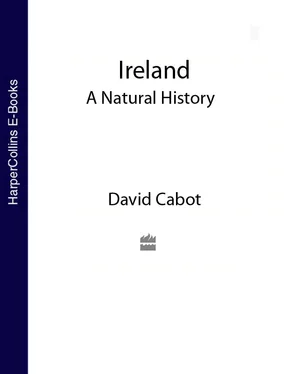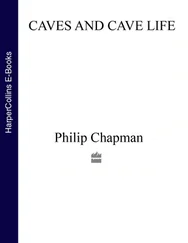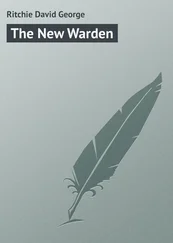Gorse, furze or whin, characteristic of the rough grassland or heaths of the lower parts of the Wicklow Mountains.
A re-survey of the area studied by Pethybridge & Praeger was carried out 50 years later by John J. Moore, champion in Ireland of the study of plant communities using the mathematical and quantitative phytosociological methods of the German botanist Braun-Blanquet. 17Moore redefined the plant communities and found that they had remained remarkably stable over the years, the main changes being an advance of bracken, extending its range by a maximum distance of 150 m, and to a lesser extent of western gorse, into abandoned farmland. A widespread reduction in the frequency of the woolly fringe-moss in the high land was also observed.
The Galway and Mayo highlands
The great metamorphic rock masses of west Galway and Mayo stretch some 120 km from south Connemara to north Erris in one of the wildest and most beautiful parts of Ireland. In the south, the Twelve Bens stand out as rugged steep-sided mountains with quartzite peaks, many of which are higher than 600 m. Although the region is described as the Twelve Bens, there are, as pointed out by Hart, 17 more or less detached peaks from about 457–731 m. 8Mica schists appear in the western peaks and through weathering break down to provide the more attractive calcareous soils on which many mountain species thrive in an abundance rarely attained elsewhere in Ireland. To the east of Lough Inagh, defining the eastern boundary of the Twelve Bens, lie the Maumturk Mountains, a large ridge of quartzite, peaking at 702 m. Blanket bogland, characterised by purple moor-grass which grows with extreme luxuriance, dominates the Connemara slopes to about 300 m before giving way to vegetation in which heather is the key species.
Irish mountains and uplands are invariably bleak, generally bereft of woody vegetation above 300 m. Here, in the neighbourhood of the Killary Harbour, Co. Mayo, the siliceous soils, derived from Silurian slates and shales, offer little opportunity for a diverse vegetation.
Bengower is one of the most southerly peaks of the Twelve Bens and its summit reaches 666 m. The vegetation of the north-facing slope at 550 m was examined in the early 1960s by Ratcliffe, the first to give a detailed description of the flora of that particular stretch. 18No remarkable specimens were found apart from the liverwort Adelanthus lindenbergianus, a southern hemisphere species first discovered at Slievemore, Achill Island, Co. Mayo, in 1903 by H. W. Lett – when it was mistakenly named as an endemic, A. dugortiensis – and only known from these two stations and from Errigal and Muckish Mountains, Co. Donegal.
Praeger wrote that the best ground for the botanist is Muckanaght (654 m) in the centre of the Twelve Bens, where ‘an oasis of schist in a Sahara of quartz’ encourages a ‘very pretty colony of alpine plants’. 3Alpine meadow-rue, purple saxifrage, mountain sorrel, alpine saw-wort, dwarf willow and holly fern grow here. Ever since Wade first published a list, albeit slender, of the flora of Connemara – in which he recorded the first discovery in Ireland of the American species pipewort 19– Connemara has attracted a continuous procession of distinguished botanists and naturalists. The most extensive botanical investigations of the Connemara mountains were carried out by Hart, whose 1883 paper remains a standard text today. 8Colgan followed soon afterwards with a less ambitious work 2and Praeger was also a frequent visitor from the early part of this century. 3More recent investigations on mountain plants have been published by Roden 20, while Webb & Scannell provide an account of all Connemara plants in Flora of Connemara and the Burren. 21
Slievemore, Achill Island, Co. Mayo, in the distance.
Mweelrea Mountain, Co. Mayo
The Irish name of this highest mountain in Connacht – An maol riabhach : ‘the grey bald mountain top’ – fits it perfectly. Built of Silurian slates and shales chiefly with sandstones, schists and conglomerates, it presides boldly over a remote corner of southwestern Mayo, overlooking Killary Harbour. To the north are the islands of Clare and Achill; to the east the more stark grey mountain of Ben Gorm (700 m) and the Sheeffry Hills (highest point 762 m). Whilst in many respects a smooth and accessible mountain, Mweelrea has high vertical cliffs on the inland side. As observed by Hart when he visited the summit (814 m) in the summer of 1882, the prospects for alpine plants are raised but not completely fulfilled by ‘the long ranges of precipices, ridges and gullies ending in ravines with sheer sides and dangerous nooks’. Once he got to the top he found the following, amongst other species: St Patrick’s cabbage, starry saxifrage, roseroot, the hawkweeds Hieracium anglicum and H. iricum, bearberry, mountain sorrel, dwarf willow, stiff sedge, tufted hair-grass, alpine clubmoss, lesser clubmoss and quillwort.
During a visit in September 1961, while examining the cliffs at the head of the great north corrie at nearly 790 m on the east spur of Mweelrea, Ratcliffe discovered the liverwort Jamesoniella carringtonii, widespread in the Scottish Highlands but never previously recorded in Ireland. On Mweelrea it was found growing sparingly on broken cliffs and ledges amongst tufts of other liverworts – Herbertus aduncus subsp. hutchinsiae, Pleurozia purpurea, Bazzania pearsonii, B. tricrenata, Scapania ornithopodioides, S. gracilis and Plagiochila spinulosa . 18
Mweelrea Mountain, Co. Mayo. The scree slopes support little vegetation.
Macgillycuddy’s Reeks and Brandon Mountain, Co. Kerry
The Macgillycuddy’s Reeks in Kerry reach 1,039 m at their highest point and are made up of a number of other summits above 900 m. Despite their promising aspect, these mountains are botanically a disappointment. The arctic-alpine and alpine species recorded by Praeger above 914 m included alpine scurvygrass, roseroot, starry saxifrage, mountain sorrel, dwarf willow, stiff sedge, alpine hair-grass, green spleenwort and alpine clubmoss. The hoary whitlowgrass, another arctic-alpine, can be found lower down but the best places to encounter the arctic-alpine and alpine species are the cliffs south of Lough Eagher at the head of Cumloughra Glen, and the series of coombs – steep cliffs with boulder scree – north of Lough Gouragh. The Kerry speciality, the strawberry-tree, is found at an altitude of 160 m, while the delicate Tunbridge filmy-fern and Killarney fern make it to 600 m and 460 m respectively. 22
Northwest of the Macgillycuddy’s Reeks, the Dingle peninsula sticks out into the Atlantic like a long, ridged finger built of sandstones and slates with its more geologically complex northwestern tip fringed with dramatic sea cliffs. The highest point there is Mount Brandon (952 m). Falling away from the eastern side of the summit the cliffs drop into a series of lakes, sometimes called paternoster lakes – they are strung out like rosary beads – each one lower than the previous one. Growing near the highest lake, at 715 m, are alternate water-milfoil and quillwort, at their most elevated stations known in Ireland. Praeger, writing in the Botanist in Ireland , reckoned that these cliffs were a repository of interesting species: ‘the richest alpine ground in the country’. Expeditions by Curtis between 1988 and 1990 in search of alpine bistort have brought renewed evidence of their richness. 23The Mount Brandon range, located in one of the remotest areas of Ireland and set in stunning scenery, would certainly repay more intensive investigations by botanists.
The arctic-alpines recorded, apart from the bistort, include alpine lady’s-mantle (found only here, at one other site in south Kerry and near Lough Ouler, Co. Wicklow), alpine meadow-grass (also only here and in the Benbulbin mountain range, Co. Sligo), alpine meadow-rue, alpine saw-wort, dwarf willow, yellow saxifrage, purple saxifrage, starry saxifrage, mountain sorrel and the alpine species, holly fern. The holly fern, like two other ferns present – the parsley fern and green spleenwort – is one of the true mountain ferns, and is usually found growing in crevices of base-rich rocks. The victim of unscrupulous plant collectors in the past, it is restricted to western Ireland where it has been recorded from seven sites, the most easterly being in Co. Fermanagh. 16
Читать дальше












